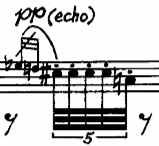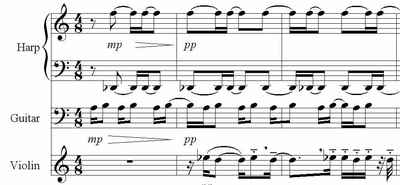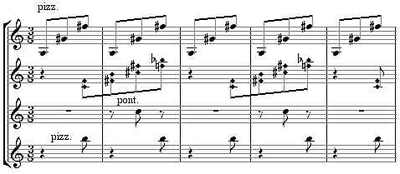main: October 2010 Archives
Egyptian Two-Step - the first piece I heard, and which made me sit up and take notice with its aerosol spray cans as percussion, performed by the E.A.R. Unit
Breaking the Chink - performed by Icebreaker
from Sgt. Pecker, his Beatles parody:
Taller than Jesus
Man, My Guitar Playing Really Reeks
Where Can I Bury My Shark?
9 Revolutions per Minute
Endless Bummer - with Miroslav Tadik: third track, titled Part 1
25 Lines for 25 Quires - listen closely to the lyrics
The Queen of Spain - third movement, harpsichords and drums, based on Scarlatti
Serious Immobilities - an excerpt from his theme and variations on Satie's Vexations, the whole thing lasting 24 hours
In Arthur Jarvinen's music, spray cans hiss, mousetraps snap, window shutters flicker, pencil sharpeners grind away, and harpsichords cavort among drums with elephantine grace. You may conclude that I am describing gimmicky or at least humorous music, but you would be wrong: this music is contrapuntal, thoughtful, purposeful, and rhythmically intricate. It's just that Jarvinen works with musical ideas so essentially rhythmic that spray cans and window shutters are sufficient to bring their essence across. I've always had this idea that a really great musician, stranded on a desert island, could make a good piece just hitting two sticks together, and Jarvinen lends credence to the idea. The more humble media you can communicate with, the closer you are to the bone marrow of music.
Again, though, put aside any notion of an American primitif. Jarvinen's The Queen of Spain - source of the harpsichords and drums mentioned above - is an almost satirical transformation of three keyboard sonatas by Domenico Scarlatti, scored for harpsichords (or electric keyboards) and percussion. He diffracted Scarlatti's transparent harmonies by adding mathematically-derived extra tones, keeping the rhythmic character of the original but blurring the lines into massively bouncing sonorities. And in Murphy-Nights, the electric keyboard and bass provide a groundwork for four wind players by playing two ostinatos over and over, one in 33/16 meter and the other in 8/4, so that with each repetition one gets a 16th-note ahead of the other.
I have no idea how this latter feat is accomplished in performance, by the way. No common bar lines connect the two parts: they just have to start with the same 16th-note pulse and keep precisely in tempo, sans conductor. Somehow on the California Ear Unit's recording (O.O. Discs 28) they get it perfect and secure.
This latter trick, abstruse as it may sound, actually points to what connects Jarvinen to his generation. If you're minimalism-conversant, it may have already occurred to you that that 33-against-32 cycling is a direct descendent of Steve Reich's Piano Phase and Come Out, which introduced different-lengthed rhythms going out of phase as a peculiarly American structural device. Like many American composers born in the 1950s, Jarvinen absorbed Reich's lessons well. Also like many of those composers, he sees no reason to limit his music to the simple contexts and pretty tonalities that formed the basic features of minimalist style.
The body of music by younger composers that evolved from minimalism to a complex rhythmic style heavily influenced by world musics has come to be called Totalism. It is primarily a New York City phenomenon, but Jarvinen, rooted in Los Angeles, is the most visible West-Coast example so far. The word totalism (far from universally accepted yet) has implications of having your cake and eating it too, being accessible and clear on one hand, yet also intricate and complexly structured enough to sustain the interest of cognoscenti. As Mozart wrote to his father about the quartets he was writing in 1782, the totalists can say of their music, "There are many passages here and there from which connoisseurs alone can derive satsifaction; but these passages are written in such a way that the less learned cannot fail to be pleased, though without knowing why."
Without courting collage, totalists pack a lot of disparate streams into their music, especially jazz and world musics: listen to the jazz trombone solo that opens Jarvinen's Erase the Fake; the improvised violin solo in the middle of Murphy-Nights; the charmingly authentic, Piazzola-esque melody of his Cheap Suit Tango. Some features, however, are quintessentially totalist. I direct your attention to the wild unison line played by sextet at the beginning of The Vulture's Garden. or the jazzy unison melody played by quartet in Murphy-Nights. This kind of ensemble doubling evolved out of the Philip Glass-Steve Reich ensemble concept (though Messiaen's Quartet for the End of Time is a first cousin), and is turned here toward athletically non-minimalist ends.
This is difficult music to play, even though clear-lined, melodic, and devoid of the 11-against-9 grupetti and rhythmic fragmentation of an Elliott Carter or a Pierre Boulez. And why, since it scorns such complexities, is it so difficult? Because, like every new style, it demands of performers a certain sensibility that must be internalized. The unison lines and rhythms of totalist chamber music entail an ensemble unity of gesture quite different from the heavily-counted Babbitt serialist work or the flexible, diversely-functioned give-and-take of a Schumann piano quintet. The smooth uniformity of line, casual yet without swell or nuance, demands ears nurtured on the minimalism of Terry Riley and Phillip Glass, and hands and lips that can swing like John Coltrane.
If I may ascend my soap box and preach just the briefest sermon, very few chamber ensembles have learned to negotiate music derived from minimalist influences because they don't perceive the difficulties involved. They glance at the score, see a line of unison 8th-notes, say to themselves, "Oh, this is nothing, I played the Carter Fourth String Quartet," and then they proceed to underrehearse and perform miserably. I've heard it all too often. I've heard members of the New York Philharmonic do a laughable job on a piece as simple as Terry Riley's In C. A handful of groups, like the California EAR Unit, Relache, Kronos Quartet, and Essential Music have superbly cultivated the technique needed for post-minimalist music. What are the rest waiting for, a message from God? As Schoenberg said - and it applies again in each new generation - "My music isn't modern, it's only badly played."
You won't find any such problems, however, on Jarvinen's CDs, mostly performed by the California EAR Unit, of which Jarvinen is a percussion-hitting and guitar-wielding member. For the most extreme instance of his bizarre timbral imagination, listen to The Paces of Yu, scored for mousetraps, window shutters, fishing reel, and - the one pitched instrument - Brazilian berimbau, a kind of one-stringed violin. Such music has the awkwardness of sincerity. It is meditative, not in the hypnotic sense, but in the thoughtful, slowly-turning, Emersonian sense of examining a musical idea from every angle. Jarvinen is sufficiently immersed in history to be a true representative of his generation - and honest and original enough to set himself apart from it as well.
I teach writing, and one of the first questions I ask my students every semester is, who are you writing for? The answer, 9 times out of 10, is that they write for themselves. I tell them that I understand -- that I go home every night, make an elaborate cake and eat it all by myself. By which I mean that cakes, and books, are meant to be presented to others. And further, that books (unlike cakes) are deep, elaborate interactions between writers and readers, albeit separated by time and space.
I remind them, as well, that no one wants to read their stories. There are a lot of other stories out there, and by now, in the 21st century, there's been such an accumulation of literature that few of us will live long enough to read all the great stories and novels, never mind the pretty good ones. Not to mention the fact that we, as readers, are busy.
We have large and difficult lives. We have, variously, jobs to do, spouses and children to attend to, errands to run, friends to see...
What the writer is saying, essentially, is this: Make room in all that for this. Stop what you're doing and read this. It had better be apparent, from the opening line, that we're offering readers something worth their while.
I should admit that when I was as young as my students are now, I too thought of myself as writing either for myself, for some ghostly ideal reader, or, at my most grandiose moments, for future generations. My work suffered as a result.
He describes meeting a very tired divorcée named Helen, holding down three jobs, whose only great diversion in life was reading:
Helen had no school-inspired sense of what she was supposed to enjoy more, and what less. She simply needed what any good reader needs: absorption, emotion, momentum and the sense of being transported from the world in which she lived and transplanted into another one.
I began to think of myself as trying to write a book that would matter to Helen. And, I have to tell you, it changed my writing. I'd seen, rather suddenly, that writing is not only an exercise in self-expression, it is also, more important, a gift we as writers are trying to give to readers. Writing a book for Helen, or for someone like Helen, is a manageable goal.
Unlike Cunningham, I have never said that I wrote for myself. I always liked Gertrude Stein's declaration, "I write for myself and for strangers" - because it embarrassed her to have friends read her writing - but in truth I am disappointed if my music is playing and a passerby, any passerby, doesn't stop to ask, with a twinkle of curiosity, "What is THAT?" I write music that I want to hear, of course, but there are musics that I myself dearly love, like those of Phill Niblock and Stefan Wolpe, that I would never write, because they are esoteric enough to seem predestined for only a narrow specialist appeal, even though it's wide enough to include me. If that makes me a middlebrow composer, then I'll proudly wave the middlebrow banner. "I write for myself" is one of those self-defeating clichés that academia acculturates young composers into, like "The music should speak for itself!" I can't imagine that any young artist starts out thinking that his work need only bring pleasure to himself. It's a defense to be used against having failed to engage the interest of others, which happens to us all now and then.
I also liked Cunningham here:
Here's a secret. Many novelists, if they are pressed and if they are being honest, will admit that the finished book is a rather rough translation of the book they'd intended to write. It's one of the heartbreaks of writing fiction. You have, for months or years, been walking around with the idea of a novel in your mind, and in your mind it's transcendent, it's brilliantly comic and howlingly tragic, it contains everything you know, and everything you can imagine, about human life on the planet earth. It is vast and mysterious and awe-inspiring. It is a cathedral made of fire....
A novel, any novel, if it's any good, is not only a slightly disappointing translation of the novelist's grandest intentions, it is also the most finished draft he could come up with before he collapsed from exhaustion. It's all I can do not to go from bookstore to bookstore with a pen, grabbing my books from the shelves, crossing out certain lines I've come to regret and inserting better ones. For many of us, there is not what you could call a "definitive text."
This is partly why I can't get into highly detailed notation. I put staccato dots on a few notes and call a piece finished, and the next day I wake up and look at it and say, "No no, that should be legato!", and draw in a slur instead, and afterward I'll change my mind again. The piece changes for me too much in my head to try to obsessively pin it down with interpretive markings. The score is a guide, like lines in a play, not a fixed objet d'art.
Such things should be admitted in the music world more often, and would be, if we were more concerned with being artists and less with being professionals.
Sites To See
AJ Blogs
AJBlogCentral | rssculture
Terry Teachout on the arts in New York City
Andrew Taylor on the business of arts & culture
rock culture approximately
Laura Collins-Hughes on arts, culture and coverage
Richard Kessler on arts education
Douglas McLennan's blog
Dalouge Smith advocates for the Arts
Art from the American Outback
Chloe Veltman on how culture will save the world
For immediate release: the arts are marketable
No genre is the new genre
David Jays on theatre and dance
Paul Levy measures the Angles
Judith H. Dobrzynski on Culture
John Rockwell on the arts
innovations and impediments in not-for-profit arts
Jan Herman - arts, media & culture with 'tude
dance
Apollinaire Scherr talks about dance
Tobi Tobias on dance et al...
jazz
Howard Mandel's freelance Urban Improvisation
Focus on New Orleans. Jazz and Other Sounds
Doug Ramsey on Jazz and other matters...
media
Jeff Weinstein's Cultural Mixology
Martha Bayles on Film...
classical music
Fresh ideas on building arts communities
Greg Sandow performs a book-in-progress
Harvey Sachs on music, and various digressions
Bruce Brubaker on all things Piano
Kyle Gann on music after the fact
Greg Sandow on the future of Classical Music
Norman Lebrecht on Shifting Sound Worlds
Joe Horowitz on music
publishing
Jerome Weeks on Books
Scott McLemee on books, ideas & trash-culture ephemera
theatre
Wendy Rosenfield: covering drama, onstage and off
visual
Public Art, Public Space
Regina Hackett takes her Art To Go
John Perreault's art diary
Lee Rosenbaum's Cultural Commentary





